Factors affecting the role of women in the economic development of rural household families in Vietnam: A case study in Trieu Son district Thanh Hoa province
This study aims to analyze the factors affecting the role of women in the economic development of
rural household families in Vietnam. 210 survey samples collected in Trieu Son district, Thanh Hoa
province were used as data in the study. The study finds a number of important factors influencing the
role of women in rural household economic development. Since then, some meaningful solutions to
promote the role of women in the economic development of rural household families in Trieu Son
district are proposed in the study.
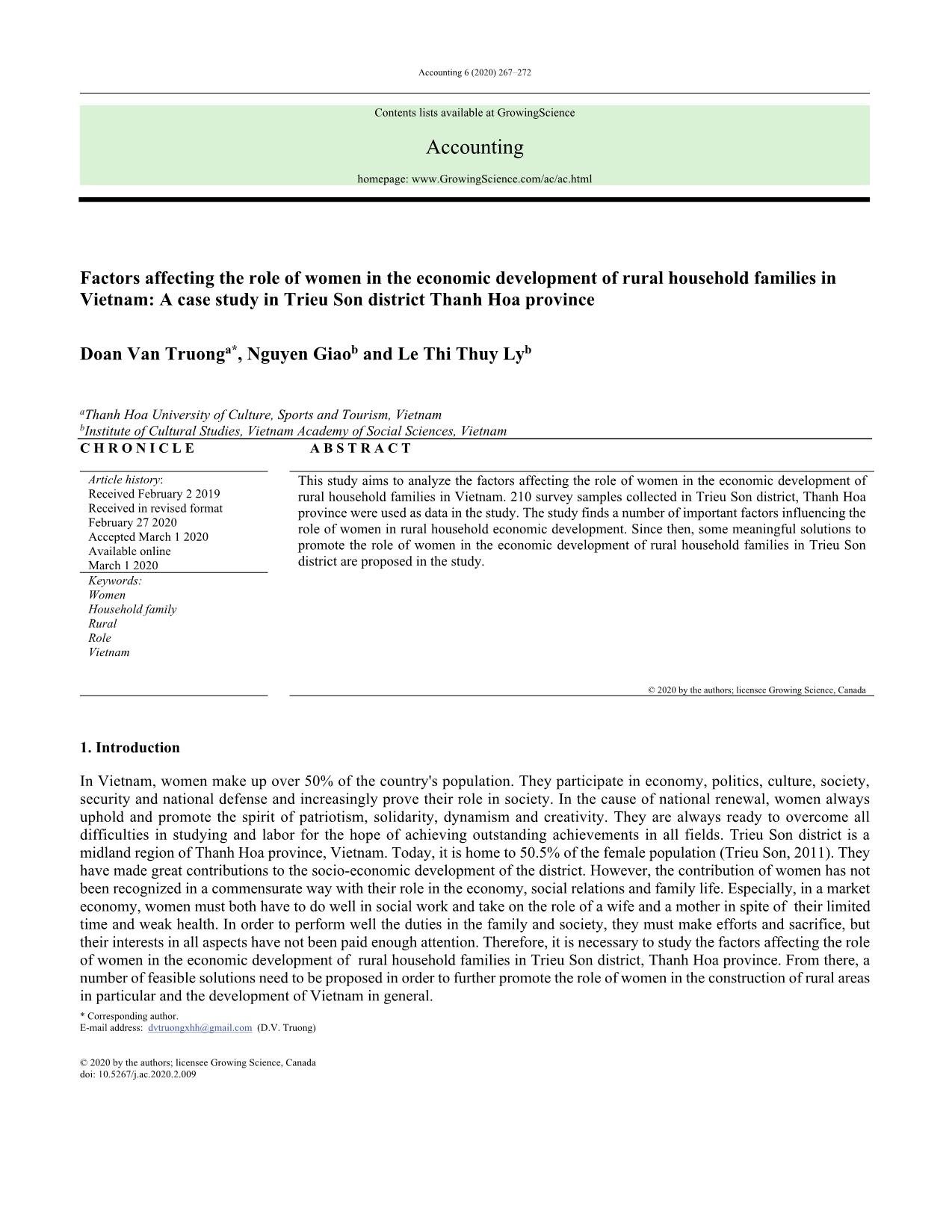
Trang 1
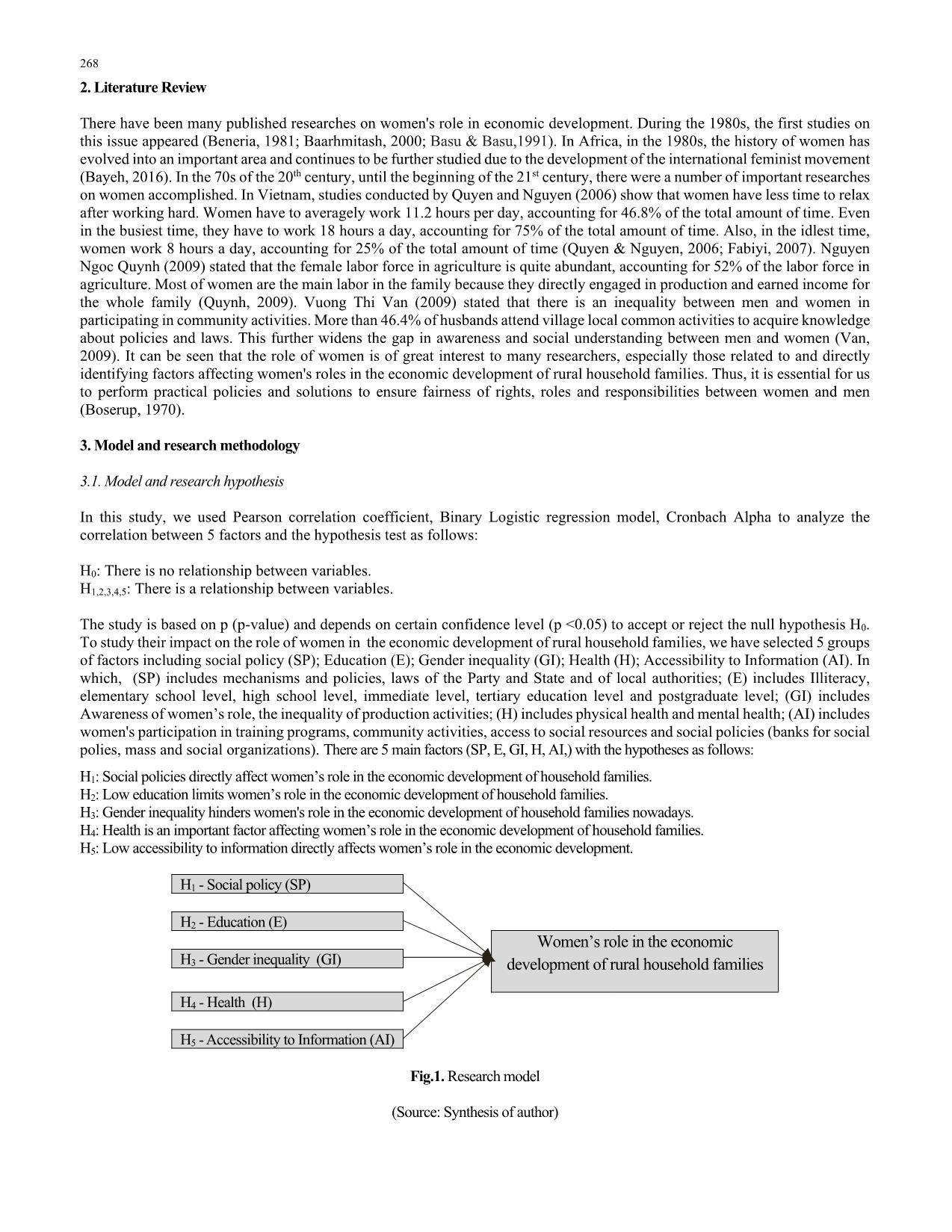
Trang 2
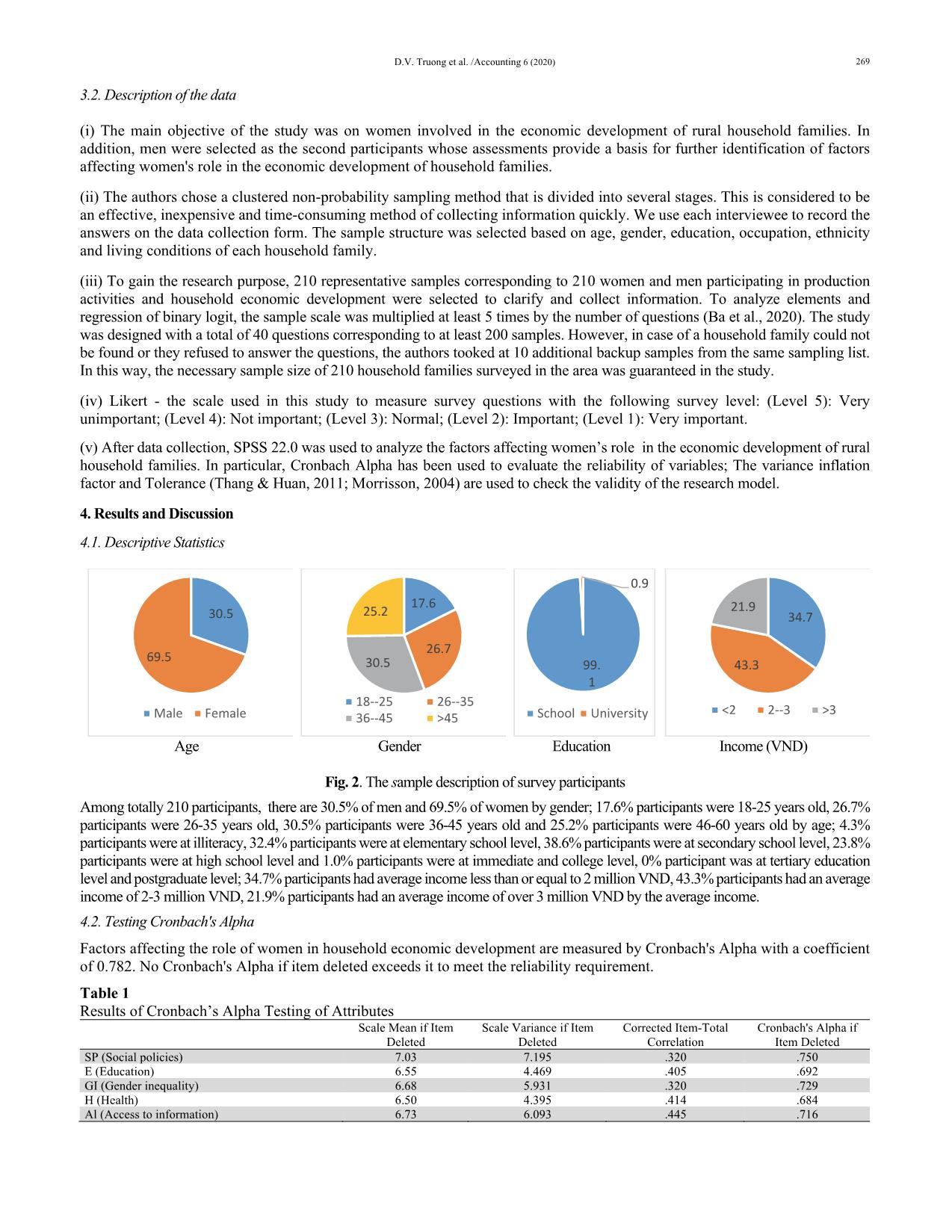
Trang 3
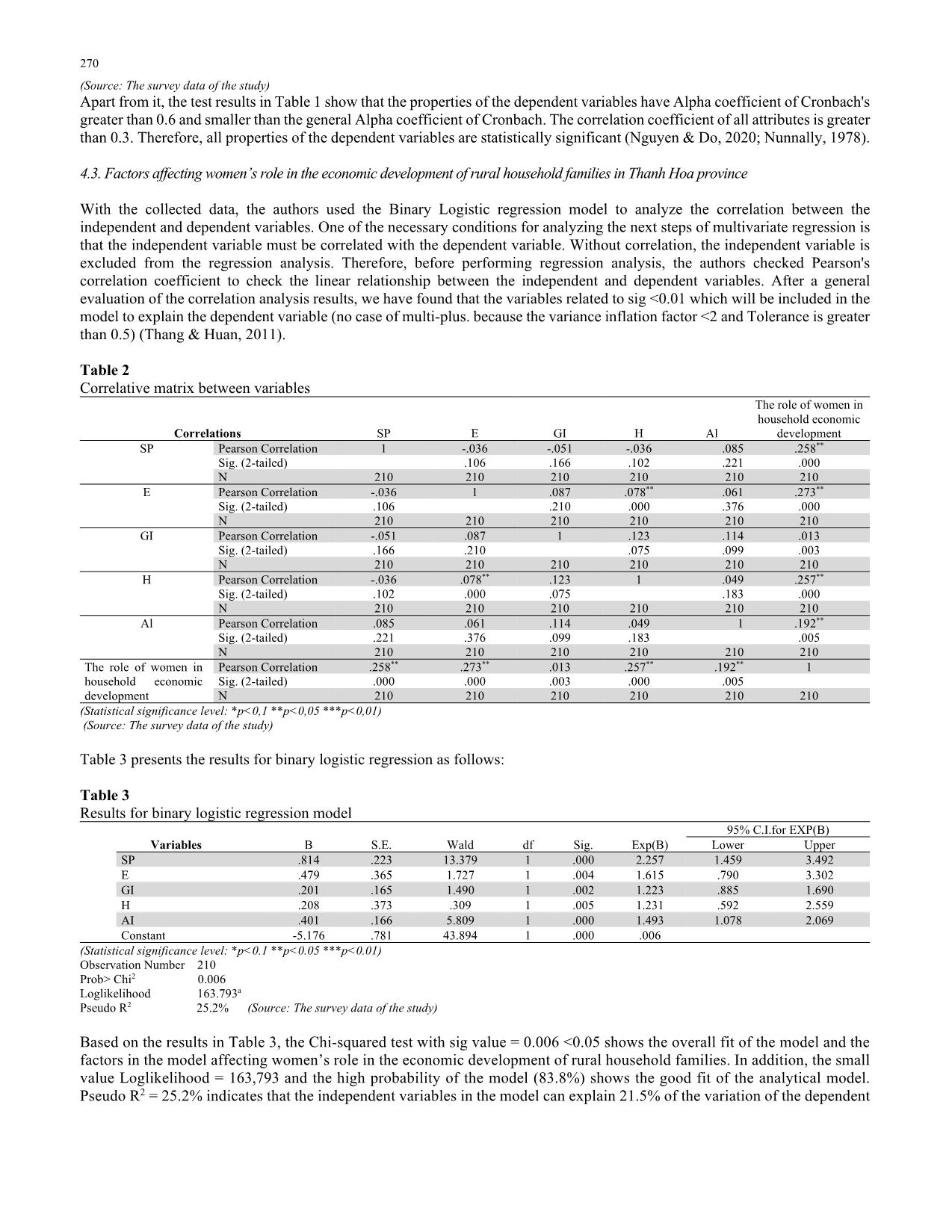
Trang 4
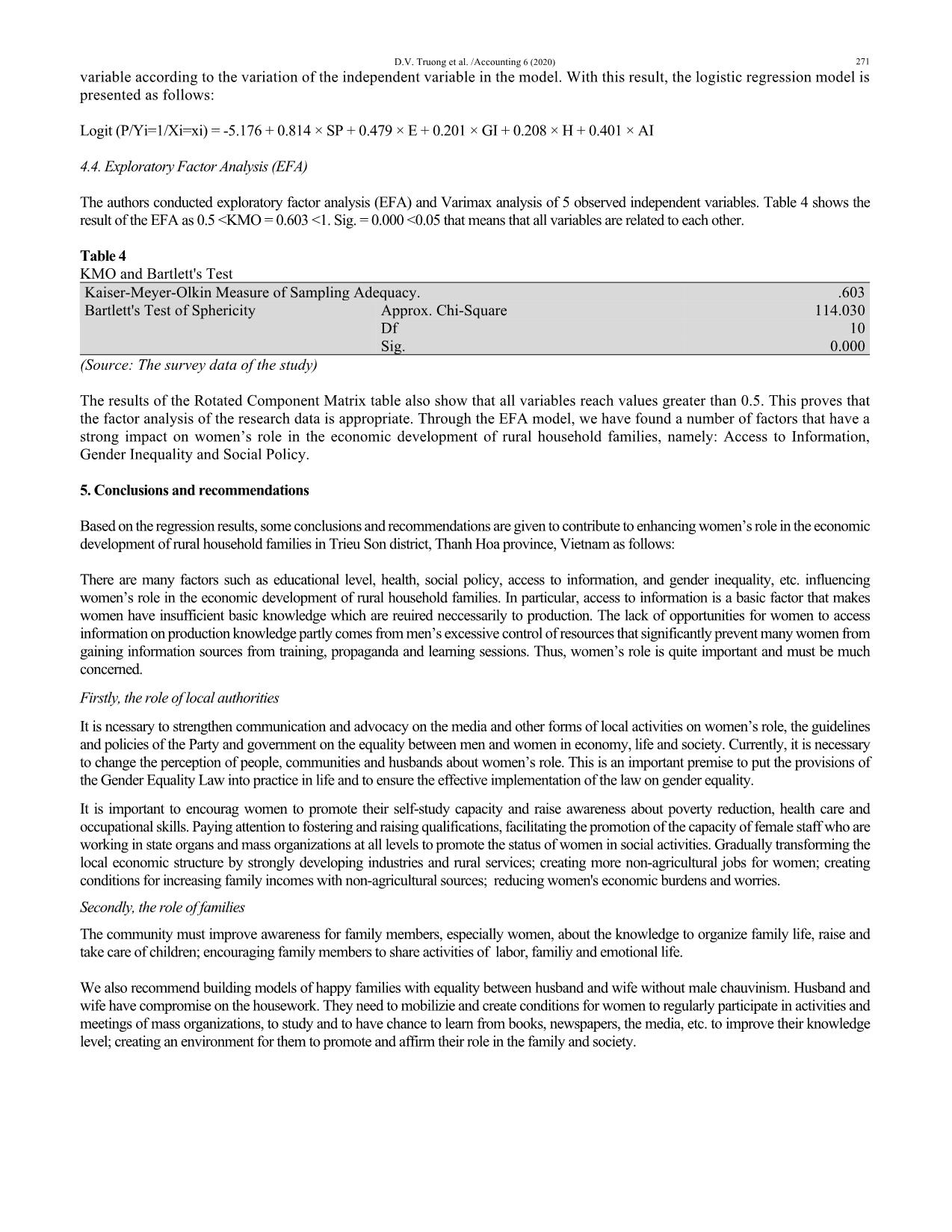
Trang 5
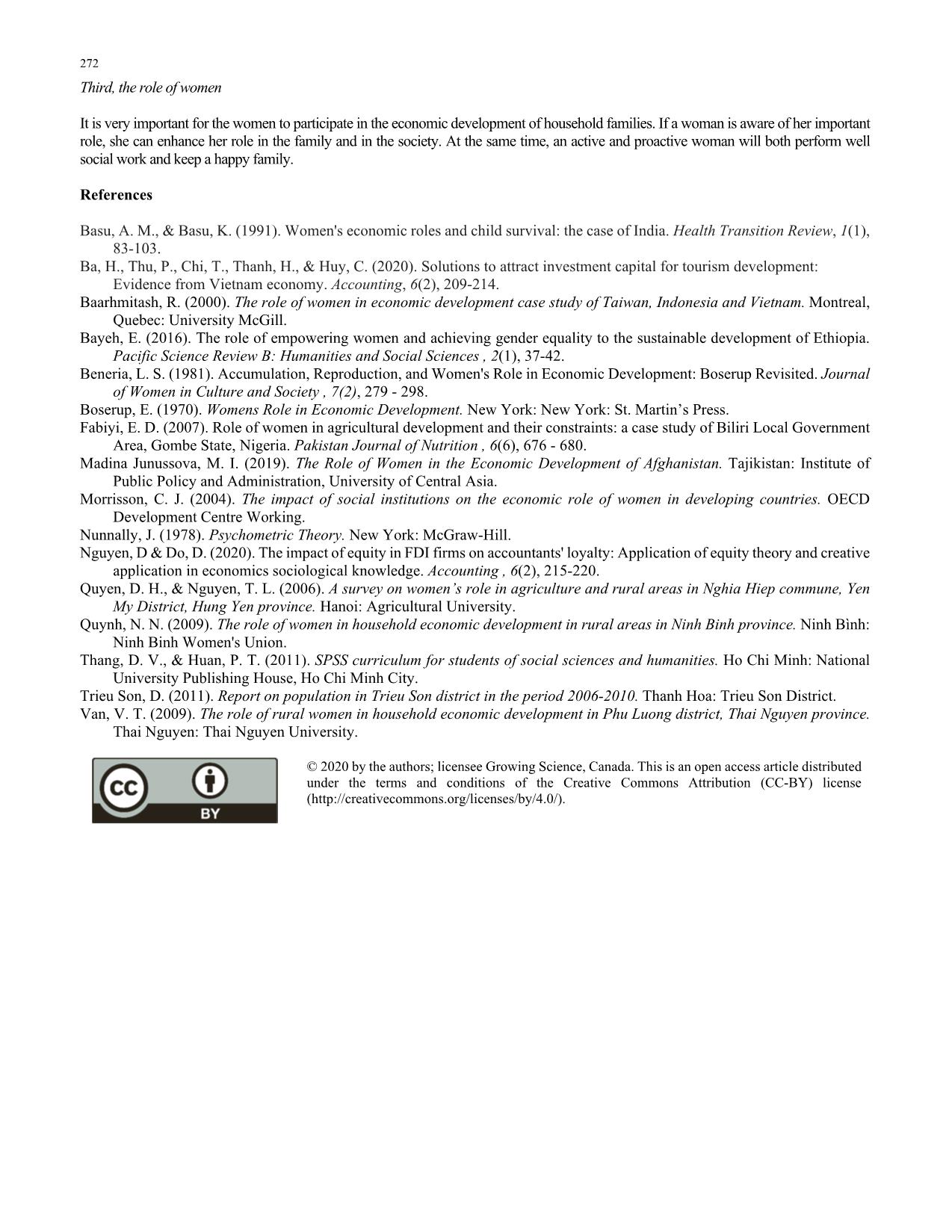
Trang 6
Bạn đang xem tài liệu "Factors affecting the role of women in the economic development of rural household families in Vietnam: A case study in Trieu Son district Thanh Hoa province", để tải tài liệu gốc về máy hãy click vào nút Download ở trên
Tóm tắt nội dung tài liệu: Factors affecting the role of women in the economic development of rural household families in Vietnam: A case study in Trieu Son district Thanh Hoa province
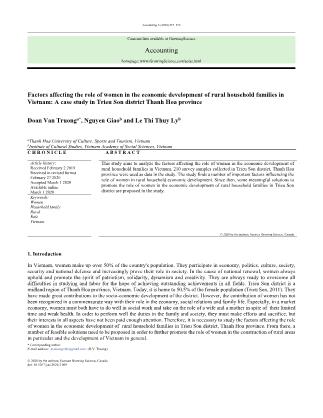
he data (i) The main objective of the study was on women involved in the economic development of rural household families. In addition, men were selected as the second participants whose assessments provide a basis for further identification of factors affecting women's role in the economic development of household families. (ii) The authors chose a clustered non-probability sampling method that is divided into several stages. This is considered to be an effective, inexpensive and time-consuming method of collecting information quickly. We use each interviewee to record the answers on the data collection form. The sample structure was selected based on age, gender, education, occupation, ethnicity and living conditions of each household family. (iii) To gain the research purpose, 210 representative samples corresponding to 210 women and men participating in production activities and household economic development were selected to clarify and collect information. To analyze elements and regression of binary logit, the sample scale was multiplied at least 5 times by the number of questions (Ba et al., 2020). The study was designed with a total of 40 questions corresponding to at least 200 samples. However, in case of a household family could not be found or they refused to answer the questions, the authors tooked at 10 additional backup samples from the same sampling list. In this way, the necessary sample size of 210 household families surveyed in the area was guaranteed in the study. (iv) Likert - the scale used in this study to measure survey questions with the following survey level: (Level 5): Very unimportant; (Level 4): Not important; (Level 3): Normal; (Level 2): Important; (Level 1): Very important. (v) After data collection, SPSS 22.0 was used to analyze the factors affecting women’s role in the economic development of rural household families. In particular, Cronbach Alpha has been used to evaluate the reliability of variables; The variance inflation factor and Tolerance (Thang & Huan, 2011; Morrisson, 2004) are used to check the validity of the research model. 4. Results and Discussion 4.1. Descriptive Statistics Age Gender Education Income (VND) Fig. 2. The sample description of survey participants Among totally 210 participants, there are 30.5% of men and 69.5% of women by gender; 17.6% participants were 18-25 years old, 26.7% participants were 26-35 years old, 30.5% participants were 36-45 years old and 25.2% participants were 46-60 years old by age; 4.3% participants were at illiteracy, 32.4% participants were at elementary school level, 38.6% participants were at secondary school level, 23.8% participants were at high school level and 1.0% participants were at immediate and college level, 0% participant was at tertiary education level and postgraduate level; 34.7% participants had average income less than or equal to 2 million VND, 43.3% participants had an average income of 2-3 million VND, 21.9% participants had an average income of over 3 million VND by the average income. 4.2. Testing Cronbach's Alpha Factors affecting the role of women in household economic development are measured by Cronbach's Alpha with a coefficient of 0.782. No Cronbach's Alpha if item deleted exceeds it to meet the reliability requirement. Table 1 Results of Cronbach’s Alpha Testing of Attributes Scale Mean if Item Deleted Scale Variance if Item Deleted Corrected Item-Total Correlation Cronbach's Alpha if Item Deleted SP (Social policies) 7.03 7.195 .320 .750 E (Education) 6.55 4.469 .405 .692 GI (Gender inequality) 6.68 5.931 .320 .729 H (Health) 6.50 4.395 .414 .684 Al (Access to information) 6.73 6.093 .445 .716 30.5 69.5 Male Female 17.6 26.7 30.5 25.2 18--25 26--35 36--45 >45 99. 1 0.9 School University 34.7 43.3 21.9 3 270 (Source: The survey data of the study) Apart from it, the test results in Table 1 show that the properties of the dependent variables have Alpha coefficient of Cronbach's greater than 0.6 and smaller than the general Alpha coefficient of Cronbach. The correlation coefficient of all attributes is greater than 0.3. Therefore, all properties of the dependent variables are statistically significant (Nguyen & Do, 2020; Nunnally, 1978). 4.3. Factors affecting women’s role in the economic development of rural household families in Thanh Hoa province With the collected data, the authors used the Binary Logistic regression model to analyze the correlation between the independent and dependent variables. One of the necessary conditions for analyzing the next steps of multivariate regression is that the independent variable must be correlated with the dependent variable. Without correlation, the independent variable is excluded from the regression analysis. Therefore, before performing regression analysis, the authors checked Pearson's correlation coefficient to check the linear relationship between the independent and dependent variables. After a general evaluation of the correlation analysis results, we have found that the variables related to sig <0.01 which will be included in the model to explain the dependent variable (no case of multi-plus. because the variance inflation factor <2 and Tolerance is greater than 0.5) (Thang & Huan, 2011). Table 2 Correlative matrix between variables Correlations SP E GI H Al The role of women in household economic development SP Pearson Correlation 1 -.036 -.051 -.036 .085 .258** Sig. (2-tailed) .106 .166 .102 .221 .000 N 210 210 210 210 210 210 E Pearson Correlation -.036 1 .087 .078** .061 .273** Sig. (2-tailed) .106 .210 .000 .376 .000 N 210 210 210 210 210 210 GI Pearson Correlation -.051 .087 1 .123 .114 .013 Sig. (2-tailed) .166 .210 .075 .099 .003 N 210 210 210 210 210 210 H Pearson Correlation -.036 .078** .123 1 .049 .257** Sig. (2-tailed) .102 .000 .075 .183 .000 N 210 210 210 210 210 210 Al Pearson Correlation .085 .061 .114 .049 1 .192** Sig. (2-tailed) .221 .376 .099 .183 .005 N 210 210 210 210 210 210 The role of women in household economic development Pearson Correlation .258** .273** .013 .257** .192** 1 Sig. (2-tailed) .000 .000 .003 .000 .005 N 210 210 210 210 210 210 (Statistical significance level: *p<0,1 **p<0,05 ***p<0,01) (Source: The survey data of the study) Table 3 presents the results for binary logistic regression as follows: Table 3 Results for binary logistic regression model Variables B S.E. Wald df Sig. Exp(B) 95% C.I.for EXP(B) Lower Upper SP .814 .223 13.379 1 .000 2.257 1.459 3.492 E .479 .365 1.727 1 .004 1.615 .790 3.302 GI .201 .165 1.490 1 .002 1.223 .885 1.690 H .208 .373 .309 1 .005 1.231 .592 2.559 AI .401 .166 5.809 1 .000 1.493 1.078 2.069 Constant -5.176 .781 43.894 1 .000 .006 (Statistical significance level: *p<0.1 **p<0.05 ***p<0.01) Observation Number 210 Prob> Chi2 0.006 Loglikelihood 163.793a Pseudo R2 25.2% (Source: The survey data of the study) Based on the results in Table 3, the Chi-squared test with sig value = 0.006 <0.05 shows the overall fit of the model and the factors in the model affecting women’s role in the economic development of rural household families. In addition, the small value Loglikelihood = 163,793 and the high probability of the model (83.8%) shows the good fit of the analytical model. Pseudo R2 = 25.2% indicates that the independent variables in the model can explain 21.5% of the variation of the dependent D.V. Truong et al. /Accounting 6 (2020) 271 variable according to the variation of the independent variable in the model. With this result, the logistic regression model is presented as follows: Logit (P/Yi=1/Xi=xi) = -5.176 + 0.814 × SP + 0.479 × E + 0.201 × GI + 0.208 × H + 0.401 × AI 4.4. Exploratory Factor Analysis (EFA) The authors conducted exploratory factor analysis (EFA) and Varimax analysis of 5 observed independent variables. Table 4 shows the result of the EFA as 0.5 <KMO = 0.603 <1. Sig. = 0.000 <0.05 that means that all variables are related to each other. Table 4 KMO and Bartlett's Test Kaiser-Meyer-Olkin Measure of Sampling Adequacy. .603 Bartlett's Test of Sphericity Approx. Chi-Square 114.030 Df 10 Sig. 0.000 (Source: The survey data of the study) The results of the Rotated Component Matrix table also show that all variables reach values greater than 0.5. This proves that the factor analysis of the research data is appropriate. Through the EFA model, we have found a number of factors that have a strong impact on women’s role in the economic development of rural household families, namely: Access to Information, Gender Inequality and Social Policy. 5. Conclusions and recommendations Based on the regression results, some conclusions and recommendations are given to contribute to enhancing women’s role in the economic development of rural household families in Trieu Son district, Thanh Hoa province, Vietnam as follows: There are many factors such as educational level, health, social policy, access to information, and gender inequality, etc. influencing women’s role in the economic development of rural household families. In particular, access to information is a basic factor that makes women have insufficient basic knowledge which are reuired neccessarily to production. The lack of opportunities for women to access information on production knowledge partly comes from men’s excessive control of resources that significantly prevent many women from gaining information sources from training, propaganda and learning sessions. Thus, women’s role is quite important and must be much concerned. Firstly, the role of local authorities It is ncessary to strengthen communication and advocacy on the media and other forms of local activities on women’s role, the guidelines and policies of the Party and government on the equality between men and women in economy, life and society. Currently, it is necessary to change the perception of people, communities and husbands about women’s role. This is an important premise to put the provisions of the Gender Equality Law into practice in life and to ensure the effective implementation of the law on gender equality. It is important to encourag women to promote their self-study capacity and raise awareness about poverty reduction, health care and occupational skills. Paying attention to fostering and raising qualifications, facilitating the promotion of the capacity of female staff who are working in state organs and mass organizations at all levels to promote the status of women in social activities. Gradually transforming the local economic structure by strongly developing industries and rural services; creating more non-agricultural jobs for women; creating conditions for increasing family incomes with non-agricultural sources; reducing women's economic burdens and worries. Secondly, the role of families The community must improve awareness for family members, especially women, about the knowledge to organize family life, raise and take care of children; encouraging family members to share activities of labor, familiy and emotional life. We also recommend building models of happy families with equality between husband and wife without male chauvinism. Husband and wife have compromise on the housework. They need to mobilizie and create conditions for women to regularly participate in activities and meetings of mass organizations, to study and to have chance to learn from books, newspapers, the media, etc. to improve their knowledge level; creating an environment for them to promote and affirm their role in the family and society. 272 Third, the role of women It is very important for the women to participate in the economic development of household families. If a woman is aware of her important role, she can enhance her role in the family and in the society. At the same time, an active and proactive woman will both perform well social work and keep a happy family. References Basu, A. M., & Basu, K. (1991). Women's economic roles and child survival: the case of India. Health Transition Review, 1(1), 83-103. Ba, H., Thu, P., Chi, T., Thanh, H., & Huy, C. (2020). Solutions to attract investment capital for tourism development: Evidence from Vietnam economy. Accounting, 6(2), 209-214. Baarhmitash, R. (2000). The role of women in economic development case study of Taiwan, Indonesia and Vietnam. Montreal, Quebec: University McGill. Bayeh, E. (2016). The role of empowering women and achieving gender equality to the sustainable development of Ethiopia. Pacific Science Review B: Humanities and Social Sciences , 2(1), 37-42. Beneria, L. S. (1981). Accumulation, Reproduction, and Women's Role in Economic Development: Boserup Revisited. Journal of Women in Culture and Society , 7(2), 279 - 298. Boserup, E. (1970). Womens Role in Economic Development. New York: New York: St. Martin’s Press. Fabiyi, E. D. (2007). Role of women in agricultural development and their constraints: a case study of Biliri Local Government Area, Gombe State, Nigeria. Pakistan Journal of Nutrition , 6(6), 676 - 680. Madina Junussova, M. I. (2019). The Role of Women in the Economic Development of Afghanistan. Tajikistan: Institute of Public Policy and Administration, University of Central Asia. Morrisson, C. J. (2004). The impact of social institutions on the economic role of women in developing countries. OECD Development Centre Working. Nunnally, J. (1978). Psychometric Theory. New York: McGraw-Hill. Nguyen, D & Do, D. (2020). The impact of equity in FDI firms on accountants' loyalty: Application of equity theory and creative application in economics sociological knowledge. Accounting , 6(2), 215-220. Quyen, D. H., & Nguyen, T. L. (2006). A survey on women’s role in agriculture and rural areas in Nghia Hiep commune, Yen My District, Hung Yen province. Hanoi: Agricultural University. Quynh, N. N. (2009). The role of women in household economic development in rural areas in Ninh Binh province. Ninh Bình: Ninh Binh Women's Union. Thang, D. V., & Huan, P. T. (2011). SPSS curriculum for students of social sciences and humanities. Ho Chi Minh: National University Publishing House, Ho Chi Minh City. Trieu Son, D. (2011). Report on population in Trieu Son district in the period 2006-2010. Thanh Hoa: Trieu Son District. Van, V. T. (2009). The role of rural women in household economic development in Phu Luong district, Thai Nguyen province. Thai Nguyen: Thai Nguyen University. © 2020 by the authors; licensee Growing Science, Canada. This is an open access article distributed under the terms and conditions of the Creative Commons Attribution (CC-BY) license (
File đính kèm:
 factors_affecting_the_role_of_women_in_the_economic_developm.pdf
factors_affecting_the_role_of_women_in_the_economic_developm.pdf

